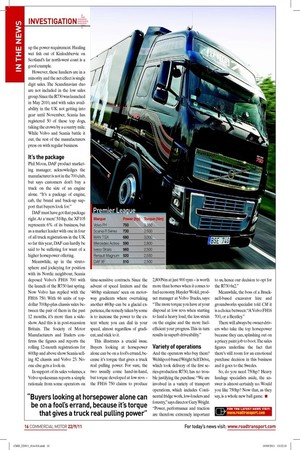Bath HGV ban will push lorries onto country roads say hauliers
Page 8

Page 9

If you've noticed an error in this article please click here to report it so we can fix it.
By Chris Tindall HAULIERS WARN that their vehicles will be pushed onto unsuitable country roads around Bath after councillors unanimously voted for an HGV ban on the edge of the city.
Bath and North East Somerset Council says it will consult with highways authorities, police and industry trade associations before the 18-month trial ban is introduced in February 2012.
The council’s claim that the 18tonne weight restriction for vehicles turning in either direction between the A36 Bathwick Street and A36 Beckford Road will boost air quality is not agreed with by transport operators.
“They say it will stop lorries taking a short cut, but it’s not a short cut, it’s a main road,” says Ray Conneely, general manager at Massey Wilcox and chairman of the region’s freight quality partnership. “It will push trafic onto the narrow roads of Wiltshire, which is ridiculous.” Conneely adds that alternative routes provided by the council might not add many miles to journeys, but the council has failed to account for the existing weight of trafic on the roads. “It’s not a matter of mileage, it’s a matter of time,” he says.
Road Haulage Association regional director Nick Payne says it is displeased with the ban. “We are not going to say we are happy with anything that will make our members’ lives more dificult.” The Freight Transport Association is equally annoyed, branding the council’s claim that it is for environmental reasons as nonsense. “It will add distance to those lorry journeys that are essential for Bath’s economy and its citizens,” says a spokesman.
“Forcing lorries off one congested local road and onto another will only serve to move the problem elsewhere.” A decision on whether to make the ban permanent will be made after the effect of the experimental trafic order is monitored. up the power requirement. Hauling wet ish out of Kinlochbervie on Scotland’s far north-west coast is a good example.
However, these hauliers are in a minority and the net effect is single digit sales. The Scandinavian duo are not included in the low sales group. Since the R730 was launched in May 2010, and with sales availability in the UK not getting into gear until November, Scania has registered 50 of these top dogs, taking the crown by a country mile. While Volvo and Scania battle it out, the rest of the manufacturers press on with regular business.
It’s the package
Phil Moon, DAF product marketing manager, acknowledges the manufacturer is not in the 700 club, but says customers don’t buy a truck on the size of an engine alone. “It’s a package of engine, cab, the brand and back-up support that buyers look for.” DAF must have got that package right. At a ‘mere’ 510hp, the XF105 represents 6% of its business, but as a market leader with one in four of all truck registrations in the UK so far this year, DAF can hardly be said to be suffering for want of a higher horsepower offering.
Meanwhile, up in the stratosphere and jockeying for position with its Nordic neighbour, Scania deposed Volvo’s FH16 700 with the launch of the R730 last spring. Now Volvo has replied with the FH16 750. With 66 units of topdollar 700hp-plus chassis sales between the pair of them in the past 12 months, it’s more than a sideshow. And this is in post-recession Britain. The Society of Motor Manufacturers and Traders conirms the igures and reports the rolling 12-month registrations for 600hp and above show Scania selling 82 chassis and Volvo 23. Noone else gets a look-in.
In support of its sales volumes, a Volvo spokesman reports a simple rationale from some operators on time-sensitive contracts. Since the advent of speed limiters and the ‘460hp stalemate’ seen on motorway gradients where overtaking another 460hp can be a glacial experience, the remedy taken by some is to increase the power to the extent where you can dial in your speed, almost regardless of gradient, and stick to it.
This illustrates a crucial issue. Buyers looking at horsepower alone can be on a fool’s errand, because it’s torque that gives a truck real pulling power. For sure, the two usually come hand-in-hand, but torque developed at low revs – the FH16 750 claims to produce 2,800Nm at just 900 rpm – is worth more than horses when it comes to fuel economy. Hayder Wokil, product manager at Volvo Trucks, says: “The more torque you have at your disposal at low revs when starting to haul a heavy load, the less strain on the engine and the more fueleficient your progress. This in turn results in superb driveability.”
Variety of operations
And the operators who buy them? Welshpool-based Wright Self Drive, which took delivery of the irst series-production R730, has no trouble justifying the purchase. “We are involved in a variety of transport operations, which includes Continental fridge work, low-loaders and forestry,” says director Gary Wright. “Power, performance and traction are therefore extremely important to us, hence our decision to opt for the R730 6x2.” Meanwhile, the boss of a Bracknell-based excavator hire and groundworks specialist told CM it is a choice between: “A Volvo FH16 700, or a Bentley.” There will always be owner-drivers who take the top horsepower because they can, splashing out on a pricey paint job to boot. The sales igures underline the fact that there’s still room for an emotional purchase decision in this business and it goes to the Swedes.
So, do you need 750hp? Heavy haulage specialists aside, the answer is almost certainly no. Would you like 750hp? Now that, as they say, is a whole new ball game. ■




































